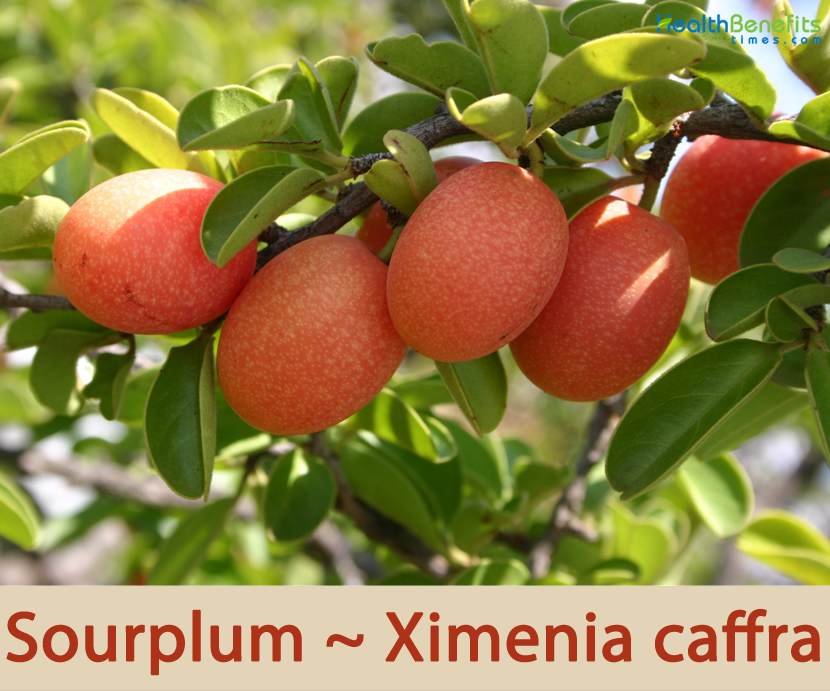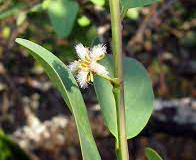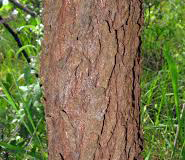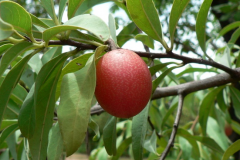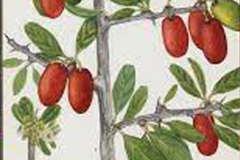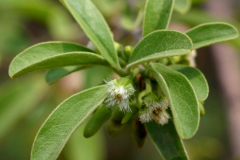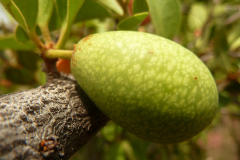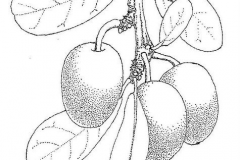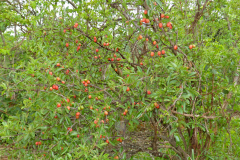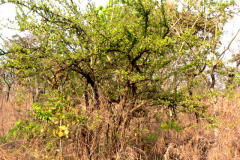| Sourplum Quick Facts | |
|---|---|
| Name: | Sourplum |
| Scientific Name: | Ximenia caffra |
| Origin | Throughout tropical regions, mostly native to regions in South East Africa, mainly Botswana, Kenya, Malawi, Mozambique, South Africa, Tanzania, Uganda, Zambia, and Zimbabwe |
| Colors | Starts green and then ripens to an orange or red |
| Shapes | Thinly fleshy, ellipsoidal or ovoid drupe, about 3.5 cm long and 2.5 cm in diameter |
| Flesh colors | Orange or red in color when ripe |
| Taste | Refreshing sour taste |
| Health benefits | Helps you achieve clear skin, Help promote healthy hair, Protect against osteoporosis, Helps relieve constipation, Good heart health, Packed with antioxidants, Helps to improve vision |
| Name | Sourplum |
|---|---|
| Scientific Name | Ximenia caffra |
| Native | Throughout tropical regions, mostly native to regions in South East Africa, mainly Botswana, Kenya, Malawi, Mozambique, South Africa, Tanzania, Uganda, Zambia, and Zimbabwe |
| Common Names | Large Sourplum, Monkey Plum, Sourplum |
| Name in Other Languages | Afrikaans: Grootsuurpruim, suurpruim, Bara: Maanyangu Barabaig: Maanyangu Bena: Mpingipingi Bende: Msantu English: Large Sourplum, Monkey Plum, Sourplum German: Rote Wildpflaume Gogo: Mjingu, mtundwe Gorowa: Maanyangumo Hehe (Tanzania): Mtundwa Herero (Namibia): Omumbeke, ozoninga Herero (Southern Africa): Omumbeke Himba (Namibia): Omuninga Iraqw (Tanzania): Maanyangu Isanzu (Tanzania): Mtundwi Ju|’hoan (Namibia): Goeh Kerewe (Tanzania): Mseaka Kinyarwanda: Amashereka Kwangali (Namibia): Sipeke Kwangali (Southern Africa): Mpheke Kwanyama (Namibia): Oshipeke oshimbyu Lovedu (Southern Africa): Mochidi Lozi (Namibia): Milutuluha, mulutuluha Lozi (Southern Africa): Mulutulua Luvale (Southern Africa): Musongosongo Maasai (Tanzania): Lama Matengo: Mpingipingi Mbukushu (Namibia): Hambya Ndebele (Southern Africa): Itsengeni, umtunduluka Ndendeule: Mbingembinge, mpingipingi Ndonga (Namibia): Oshimbyupeke, oshipeke Ndonga (Namibia): Ombyupeke Ngindo: Mpingi Ngoni (Tanzania): Bingimbingi, mpingipingi Northern Sotho (Southern Africa): Morotologa Nyamwezi (Tanzania): Mnembwa, mtundwa Nyaturu (Tanzania): Mutundwe Nyiramba (Tanzania): Mtundwi Oshikwanyama (Namibia): Oipeke oimbyu, oipeke oinenepeke, ombyu Oshiwambo (Namibia): Oipeke oimbyu, oipeke oinenepeke, ombyu Pedi (Southern Africa): Matshidi, motshidi Rangi (Tanzania): Mjingu, miengu Rukwangali (Namibia): Sipeke Rumanyo (Namibia): Mopeke Sambaa (Tanzania): Mtundui Sandawe (Tanzania): Xaya, wandanda SeTswana (Botswana): Meretologa, moretologa, moretologa wa dipudi, moretologa wa kgoma Shona: Munhengeni, Mutengeni, Mutsvanzva, itsengeni, musanza, mutengeno, mutenguru, nhengeni, tsvanzva Sotho (Southern Africa): Masidi, motshidi Swahili (Tanzania): Mpingi Swati (Southern Africa): Umthunduluka Thimbukushu (Namibia): Hambya, thihambya Thonga (Southern Africa): Umtunduku Tswana (Botswana): Moretologa-kgomo Tswana (Southern Africa): Morokolo, morotologa, pepo, sere-tologakgomo Venda (Southern Africa): Mutanzwa Zaramo (Tanzania): Muhingi Zigua (Tanzania): Mtundwi, mhingi Zinza (Tanzania): Mseka Zulu(Southern Africa): Amanumbilo, amathunduluka, umkolotshane, amatimdolubi, umThunduluka-obomvu, umthunduluka |
| Plant Growth Habit | Semi-parasitic, spiny, sparsely-branched, deciduous shrub or a small tree |
| Growing Climates | Dry lowland woodland, wooded grassland, coastal bush land, alluvial Acacia woodland and bush land, Euphorbia woodland, riverine bush land, dry wooded bush land, rocky hillsides, termite mounds and coastal areas |
| Soil | Succeeds on clay loams, clays, compacted loamy sand, sandy clay loams, and friable clays with laterite horizon. Established plants are drought tolerant |
| Plant Size | Grow up to 6 metres tall |
| Root | Non-aggressive |
| Bark | Bark is grayish-brown to black, longitudinally fissured bark, red slash and rough on older, larger species |
| Branches | either smooth or covered with flattened hairs and armed with spines at their bases |
| Leaf | Simple, alternate, elliptic to lanceolate, 2.5-9 cm long and 1.2-5 cm wide, leathery, blue-green, often fascicled on dwarf, lateral shoots, margin entire, apex rounded or notched, base broadly tapering to rounded |
| Flowering season | September to October |
| Flower | Flowers are up to 12mm long, small, sweet scented and greenish to creamy white, during flowering, although they have been seen to be tinged pink or sometimes red |
| Fruit Shape & Size | Thinly fleshy, ellipsoidal or ovoid drupe, about 3.5 cm long and 2.5 cm in diameter |
| Fruit Color | Starts green and then ripens to an orange or red |
| Fruit Skin | Smooth |
| Flesh Color | Orange or red in color when ripe |
| Seed | Smooth, hard, ellipsoid, yellow-brown to red in color and around 2.5 cm in length |
| Propagation | By Seedlings, suckers |
| Flavor/Aroma | Almond-like scent |
| Taste | Refreshing sour taste |
| Varieties |
|
| Season | December to January |
| Health Benefits |
|
Plant Description
Sour plum is a semi-parasitic, spiny, sparsely-branched, deciduous shrub or a small tree with a shapeless untidy, open crown that normally grows up to 6 meters tall. Once planted the seeds will germinate after 14–30 days, and have a moderate growth rate of 0.5 m per year. The branches are either smooth or covered with flattened hairs and armed with spines at their bases. The bark of the tree is grayish-brown to black in color, and is longitudinally fissured. Sapwood is white and heartwood is hard and reddish brown. The root system is non-aggressive. The plant is found growing in dry lowland woodland, wooded grassland, coastal bush land, alluvial acacia woodland and bush land, euphorbia woodland, riverine bush land, dry wooded bush land, rocky hillsides, termite mounds and coastal areas. The plant succeeds on clay loams, clays, compacted loamy sand, sandy clay loams, and friable clays with laterite horizon. Established plants are drought tolerant.
Leaves
Leaves are simple, alternate, elliptic to lanceolate, 2.5-9 cm long and 1.2-5 cm wide, leathery, blue-green, often fascicled on dwarf, lateral shoots, margin entire, apex rounded or notched, base broadly tapering to rounded, often hairy when young and turning to shiny green when getting older and petiole about 8 mm long.
Flower
The flowers are up to 12mm long, small, sweet scented and greenish to creamy white, during flowering, although they have been seen to be tinged pink or sometimes red. Generally, flowering takes place in August to October in single-stem clusters in the axils of the spines or on the dwarf branchlets.
Fruit
Fertile flowers are followed by thinly fleshy, ellipsoidal or ovoid drupe, about 3.5 cm long and 2.5 cm in diameter. The skin is smooth and starts green, and then ripens to an orange or red. Similarly the flesh is also orange or red in color, and when ripe has a juicy pulp. The fruit consists of a single seed which is smooth, ellipsoid, and yellow-brown to red in color. The seed is hard and around 2.5 cm in length, 1 cm thick and hard coated.
These are tart but edible and are relished by birds, other animals and humans. The single large seed inside consists of Ximenia oil which has various uses. These have high vitamin C content and are also is high in potassium and contains protein too. The fruits are also used for making jam, dessert and jelly. They can be added to porridge.
Health benefits of Sour plum
According to different researches, Sourplum consists of beta-carotene, and it is also rich in vitamin K. Each average-sized Sourplum can give you about 0.7 g of fiber and 23 kcal of tissue. If you add at least 28 grams of Sourplum to your juice or smoothies, you can expect that you will be boosting your fiber and antioxidant intake. Experts say that one cup of Sourplum can give you at least 87% of the body’s recommended daily intake of vitamin K, 8% of calcium, more than 20% of most B vitamins, and 27% of potassium. In this article, we are going to know more about the health benefits of adding sour plum juice to your diet.
1. Helps to improve vision
Sour plum consists of good amount of vitamin A which is an essential vitamin that helps us achieve a healthy vision. Piece of sour plum can give the body’s daily recommended dose of vitamin A. People who lack vitamin A in their bodies are susceptible to have dry eyes, night blindness, cataracts, and even macular degeneration.
2. Packed with antioxidants
Some say that blueberries are rich in antioxidants, but did you know that sour plums consist of an even higher dose of antioxidants. Research showed that sour plums ranked as the number one food in terms of having a high antioxidant capacity. Sour plums also consist of good amount of manganese, plant phenolics, and iron, which all function as antioxidants and help protect our cell membranes from free radical damage.
3. Good heart health
Sour plums are high in potassium, which is a mineral that is vital to ensure the proper functioning of the heart. Having a sufficient potassium intake every day can help lower blood pressure, which in turn can reduce the risk of having problems such as heart disease, heart attack, dizziness, and stroke. Due to these reasons you should not overlook the benefits of sour plums.
4. Helps relieve constipation
Sour plums, as well as prunes, are known to be a digestive remedy for years. And according to studies, sour plums and prunes are better laxatives compared to psyllium. Sour plums and prunes help the body to digest food properly, have a regular bowel movement, and relieve constipation. This is because a piece of sour plum or prune consists of about 3% of the body’s recommended daily intake of fiber. Aside from that, it also contains a natural sugar called sorbitol, which also functions as a laxative because it helps pull moisture into the body’s digestive tract, which in turn trigger bowel movements. Just keep in mind that you should not eat too many prunes or sour plums, because it can also cause gastrointestinal distress due to excessive fiber and sorbitol content.
5. Protect against osteoporosis
Even a single serving of sour plum can help fulfill the body’s daily requirement for potassium and boron that both supports bone health. According to research, prunes might be able to reverse osteoporosis, especially in postmenopausal women. According to the research, postmenopausal women who were asked to consume 100 grams of dried plums every day showed improvement in their bone formation markers in just three months. This is compared to a control group who were asked to consume at least 75 grams of dried apples every day. Aside from this, sour plums also consist of anti-inflammatory properties, which is why it is highly recommended that people have arthritis.
6. Help promote healthy hair
Being iron deficient can cause dryness and discoloration of hair as well as hair loss. Eating or consuming sour plum can be a great source of iron, which in term helps contribute to the overall health of your hair and give countless benefits to it. Sour plums are a perfect source of vitamin B and C, which are known to be great helpers when it comes to hair growth. Aside from that, these nutrients can help strengthen your hair from roots to tips, which can prevent breakage and damage.
7. Helps you achieve clear skin
Vitamins and minerals that can be found in sour plums are helpful when it comes to maintaining healthy and clear skin. This fruit also helps to slow down the body’s aging process, which in turn delays the development of wrinkles.
Traditional uses and benefits of Sour Plum
- The leaves are vermifuge.
- Powdered dried leaves are taken orally for treating fever and infertility.
- Extracts of the leaves are used as a gargle for soothing tonsillitis.
- Decoction from the leaves is used as a wash to soothe inflamed eyes.
- Pounded leaves are used as poultices for treating wounds and boils.
- Infusions of the roots are used as a remedy for dysentery and diarrhea and, combined with the leaves, are taken as a remedy for colic, abdominal pain, malaria, coughs and bilharziasis.
- Powdered root is used in soup and in beer as an aphrodisiac, whilst a decoction is used to remedy infertility.
- Porridge made using a decoction of the roots with maize flour is eaten once a day as a remedy for nausea in pregnancy and to prevent sterility in women.
- Powdered roots are applied to sores, abscesses etc. to speed up healing.
- Roasted and pounded seeds are used as a poultice for healing wounds.
- It is traditionally used, both topically and orally to treat a wide range of human diseases and ailments such as wounds, sexually transmitted infections (STIs), infertility, stomach ache, fever, eye problems, diarrhea, bilharzia, menorrhagia, malaria, intestinal worms, impotence and coughs.
- Bark and fruits are used by small-scale farmers as ethno-veterinary medicine to treat dermatophilosis, foot rot, saddle sores and control ecto-parasites.
- Roots are used to treat abscesses, stomach aches, colic, malaria, coughs, and bilharzias.
- They can also be pounded, turned into porridge and eaten to reportedly prevent sterility in women.
- It is thought that powdered roots can also be added to beer to act as an aphrodisiac.
- Tree’s bark is used as a remedy for syphilis, hookworm, chest pains, and body pain.
- Seeds are generally roasted and then pounded for their oils to be used for wounds as an ointment.
- Leaves can be used to soothe inflamed eyes and as a reported cure for tonsillitis.
- Root is an African remedy for diarrhea in Tanganyika (Tanzania).
- Roots boiled and the decoction is used as a remedy for menstrual problems.
- Roots boiled and the decoction is used as a remedy for infertility.
- An infusion of the roots is used for pelvic disease (possibly pelvic inflammatory disease).
- In the Okavango a hot-water extract is prepared from the crushed roots, which is taken for swollen feet.
- Leaves and roots are used to treat psychological illness.
- Roots are boiled and the infusion is taken as a remedy for coughs.
Culinary Uses
- Fruit can be consumed raw.
- Best eaten when slightly over-ripe, the thin flesh has a refreshing, acid flavor and an almond-like scent.
- Refreshing drink can be prepared by squeezing the fruits in water and adding sugar.
- Fruits can also be processed into a storable jam.
- Fruits are also known to be used for desserts and jellies.
- The Zulus occasionally squeeze out the fruits into water and the resultant juice is boiled and mixed with kaffir corn meal to make a tasty sour porridge
Recipe
Sour Plum Drink
Ingredients
- 2500 ml water (about 10 cups)
- 50-100 grams dried hawthorn
- 30-100 grams dried sour plum
- 3-10 grams dried orange peel
- 3-10 grams dried licorice root
- 10-20 grams dried hibiscus flower/tea
- 1-3 grams dried osmanthus flower
- 100 grams rock sugar (or to taste)
Directions
- Rinse all the dried ingredients under running water to get rid of any dirt or debris.
- In a large pot, combine the water and the dried ingredients (if you like, you can wrap all the dried ingredients in a cheesecloth to avoid the straining step later), and soak for 1 hour.
- After soaking, bring everything to a boil, and immediately turn the heat down to low.
- Simmer (with the lid on) for 45 minutes. Add the rock sugar, let it dissolve completely, and turn off the heat to let the liquid cool.
- Once cooled, strain the liquid into a large container, and serve over ice.
- Remember to store the leftovers in the refrigerator; it will last for 3-4 days.
- You’ll know that the drink has gone bad if there are air bubbles floating on top and the liquid is opaque instead of clear!
Other Facts
- The plant is occasionally grown as part of a boundary screen and living fence.
- Roasted seeds are mashed in the mortar yielding viscous, non-drying oil.
- Oil is applied to the hair to darken its color and help straighten it.
- Oil from the seeds is used for lighting, to soften bowstrings, make cosmetic products locally, and as a general body ointment to soften the skin.
- Heartwood is reddish brown and the sapwood white.
- Wood is fine-grained, hard and is used in general construction and to make tool handles, spoons etc.
- Wood is used for fuel.
- Wood can also be used to make handles for tools, utensils, or for construction purposes.
- Oil can be used to soften leather, oiling bowstrings, or as a general ointment.
- Oil can be used cosmetically for the hair or for the skin to soothe chafing.
- Oil can also be used as fuel for lamps.
- Tree can be used as a natural fence to designate tracts of land or set a perimeter.
- The plant is moderately frost tolerant and drought resistant.
- Fruits are known to be sold in small markets.
- Ripe fruits are eaten by birds like barbets, bulbuls and starlings.
- Leaves are eaten by mammals including giraffe, impala, kudu, grey duiker, steenbok, bushbuck and eland.
- Larvae of various butterflies including the Natal bar, Silvery bar, Bowker’s sapphire, Saffron sapphire, Brown playboy and Bush scarlet butterfly feed on the leaves.
References:
https://www.cabi.org/isc/datasheet/57020
https://gd.eppo.int/taxon/XIMCA
https://tropical.theferns.info/viewtropical.php?id=Ximenia+caffra
https://en.wikipedia.org/wiki/Ximenia_caffra
http://pza.sanbi.org/ximenia-caffra
http://apps.worldagroforestry.org/treedb/AFTPDFS/Ximenia_caffra.PDF


